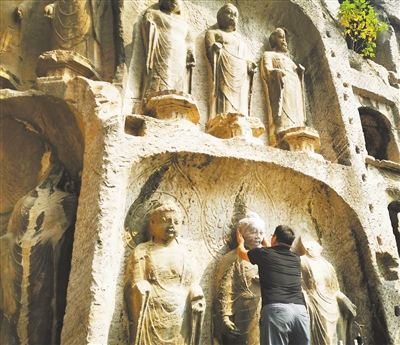
 |
| A staff member places 3D-printed Buddha's head at the Longmen Grottoes in Luoyang, Henan province. (PHOTO: XINHUA) |
The Longmen Grottoes in Luoyang, Henan province in central China, are a series of cave temples carved into the rocks of the Longmen Mountain. They are renowned for their collection of exquisite Buddhist art. The Wanfo Cave, part of the grottoes, is famous for its 15,000 Buddha statues.
In an alcove in the cave stands the statue of the graceful Guanyin, or Avalokiteshvara Bodhisattva, a Buddhist deity who embodies compassion and mercy. The goddess wears an earth-colored flowing robe with pleats and a gauze-like scarf in pale blue-green is draped around her shoulders, gently falling to the ground. Her hair is piled high on her head with a golden ornament in it. While she holds an oblong vessel in her lowered left hand, her right hand is raised to her shoulder in a gesture of benevolence.
Such details are available today thanks to technology. The original statue fell into ruins with the passage of time and the upper half of Guanyin's face disintegrated. Many art experts thought it would be impossible to restore the splendor of the original statue. However, today's high technology, such as 3D digital modeling, augmented reality, color detection and analysis, combined with AI and traditional sculpture techniques, has given a new lease of life to the statue.
The virtual restoration was based on extensive research. Luckily, about 100 years ago when the statue was still intact, some explorers and scholars had taken photographs of it. These photos provided an important basis for virtual restoration.
Today, visitors can even see what the statue looked like in different historical periods by scanning the barcode and AR versions of Guanyin emerge, showing the damage and the restoration.
The grottoes now have a digital database detailing the statues, murals and other objects of art inside the grottoes, museum collections, rubbings, and artifacts that were stolen from the caves.
Digital archives are the new way to preserve cultural relics. Since 2021, experts have been utilizing the technology to virtually repatriate the many artifacts taken abroad as well as show the damaged statues in their original form.
Researchers have also collaborated with the Palace Museum in Beijing to digitally restore nine lost cultural artifacts. In the future, the full digital reconstruction of the Longmen Grottoes is expected.


 Next
Next




